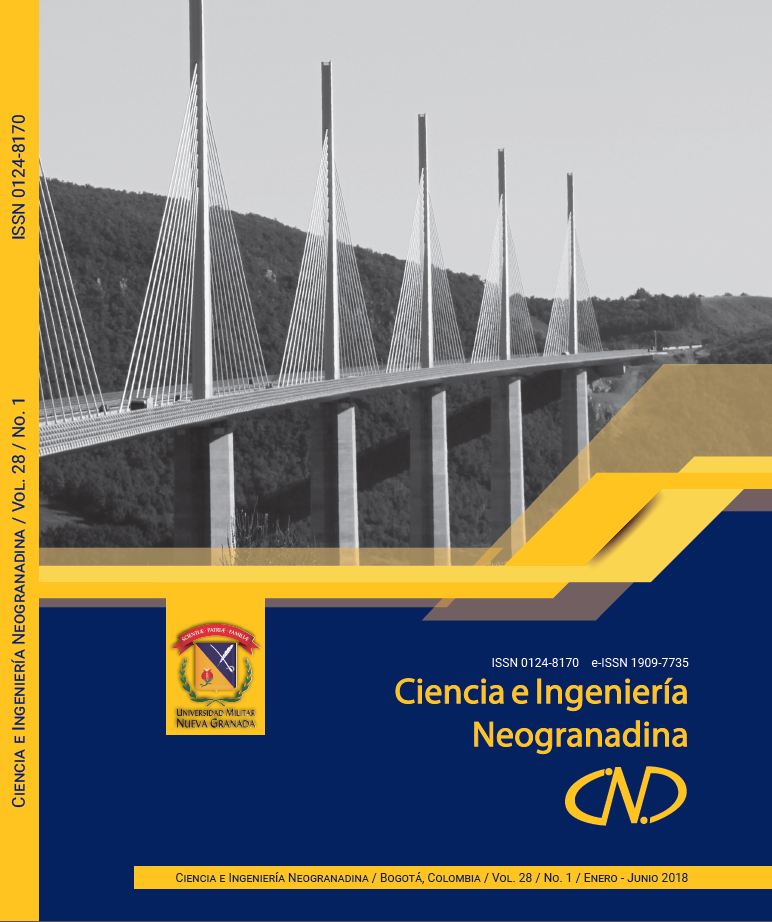Efectos de la estimulación hidráulica (fracking) en el recurso hí- drico: Implicaciones en el contexto colombiano
Resumen
La contribución de la extracción de gas lutita en la sostenibilidad energética ha sido evaluada de manera independiente, sin tener en cuenta su relación con la seguridad hídrica ni sus impactos en las fuentes de agua. Por esta razón, en la presente investigación se realizó un análisis de estos impactos a través de una revisión bibliográfica de carácter nacional e internacional. Si bien el análisis hecho sugiere dos aspectos fundamentalmente importantes: 1) impactos en el recurso hídrico asociados a la cantidad y calidad de este y 2) efectos sísmicos o sismicidad inducida, este estudio se enfoca principalmente en el primero. Los resultados de la revisión demuestran un creciente aumento de investigaciones sobre el impacto del fracking; sin embargo, se encontró que hay deficiencias en el uso de modelos numéricos para cuantificar los efectos ambientales. Adicionalmente, los resultados muestran que los consumos asociados a la estimulación hidráulica no parecen ser significativos comparados con los usos típicos en otras prácticas económicas, como la agricultura (riegos). En este sentido, en el contexto colombiano los retos se basan en consolidar una mejor red de información piezométrica y en general un sistema de monitoreo más robusto para mejorar la toma de decisiones respecto al fracking, ya que este tipo de información representa el primer paso hacia la construcción de modelos hidrogeológicos que soporten la evaluación del riesgo y contribuyan a la reducción de la posible vulnerabilidad del recurso hídrico en el desarrollo de proyectos de aprovechamiento de gas lutita.
Descargas
Agencias de apoyo:
Universidad Antonio Nariño, Juan Daniel Valderrama, Edwin González, Andrés CarvajalReferencias bibliográficas
J. Soeder, S. Sharma, N. Pekney et al., “An approach for assessing engineering risk from shale gas wells in the United States,” International Journal of Coal Geology, vol. 126, pp. 4-19, 2014. DOI: https://doi.org/10.1016/j. coal.2014.01.004
R. Heinberg, “A brief history of fracking,” 2013. [En línea]. Disponible en: http:// www.resilience.org/stories/2013-10-02/ snake-oil-chapter-2-technology-to-the- rescue/
R. Heinberg. Snake Oil: How Fracking’s False Promise of Plenty Imperils Our Future. Gran Bretaña: Clairwiew Books, 2014.
M. Soliman, J. Daal y L. East, “Fracturing unconventional formations to enhance productivity,” Journal of Natural Gas Science and Engineering, vol. 8, pp. 52-67, 2012. DOI: https://doi.org/10.1016/j.jngse.2012.01.007
D. Chuprakov y A. S. Zhubayev, “A variational approach to analyze a natural fault with hydraulic fracture based on the strain energy density criterion,” Theoretical and Applied Fracture Mechanics, vol. 53, no. 3, pp. 221-232, 2010. DOI: https://doi.org/10.1016/j. tafmec.2010.06.007
A. Bergmann, F. Weber, H. Meiners et al., “Potential water-related environmental risks of hydraulic fracturing employed in exploration and exploitation of unconventional natural gas reservoirs in Germany,” Environmental Sciences Europe, vol. 26, pp.10, 2014. DOI: https:// doi.org/10.1186/2190-4715-26-10
J. Bocora, “Global Prospects for the Development of Unconventional Gas,” Procedia - Social and Behavioral Sciences, vol. 65, pp. 436-442, 2012. DOI: https:// doi.org/10.1016/j.sbspro.2012.11.145
M. Kargbo, G. Wilhelm y J. Campbell, “Natural gas plays in the Marcellus shale: Challenges and potential opportunities,” Environmental Science & Technology, vol. 44, no. 15, pp. 5679-5684, 2010. DOI: https://doi.org/10.1021/es903811p
J. Matesanz, “Repercusiones territoriales de la fractura hidráulica o “fracking” en Cantabria, Burgos y Palencia. Los permisos de investigación Bezana y Bigüenzo,” 2013. [En línea]. Disponible en: http://eprints.sim.ucm.es/23795/
Revista Semana, “Fracking: una apuesta riesgosa para Colombia,” 2016. [En línea]. Disponible en http://sostenibilidad.semana.com/medio-ambiente/ articulo/fracking-una-apuesta-riesgosa-para-colombia/35505
D. Costa, J. Jesus, D. Branco et al., “Extensive review of shale gas environmental impacts from scientific literature (2010-2015),” Environmental Science and Pollution Research, vol. 24, no. 17, pp. 14579-14594, 2017. DOI: https:// doi.org/10.1007/s11356-017-8970-0
G. Speight. The chemistry and technology of petroleum. Boca Ratón: CRC Press, 2014.
Ecopetrol, “Qué es el gas natural,” 2014. [En línea]. Disponible en http://www.ecopetrol.com.co/wps/portal/es/ecopetrol-web/productos-y-servicios/productos/gas-natural/Informaci%25C3%25B3n%2520General/que-es-el-gas-natural/%21ut/p/z0/04_Sj9CPykssy0xPLMnMz0vMAfIjo8ziLQIMHd09DQy9DZwt3QwcjTwsQxw9g4I8nIz0C7IdFQEONbdQ/
T. Eaton, “Science-based decision-making on complex issues: Marcellus shale gas hydrofracking and New York City water supply,” Science of The Total Environment, vols. 461-462, pp. 158-169, 2013. DOI: https://doi.org/10.1016/j. scitotenv.2013.04.093
S. G. Osborn, A. Vengosh, N. R. Warner et al., “Methane contamination of drinking water accompanying gas well drilling and hydraulic fracturing,” Proceedings of the National Academy of Sciences, vol. 108, no. 20, pp. 8172-8176, 2011. DOI: https://doi. org/10.1073/pnas.1100682108
C. G. Groat y T. W. Grimshaw. Factbased regulation for environmental protection in shale gas development. Austin: The Energy Institute, University of Texas at Austin, 2012.
N. Maricic, S. D. Mohaghegh y E. Artun, “A parametric study on the benefits of drilling horizontal and multilateral wells in coalbed methane reservoirs,” SPE Reservoir Evaluation & Engineering, vol. 11, no. 06, pp. 976-983, 2008. DOI: https://doi.org/10.2118/96018-PA
J. Caputo, “Shale plays: basic geological and engineering concepts. American Association of Profesional Landmen,” 2011. [En línea]. Disponible en: http://www.landman.org/docs/white- papers/03-caputo_aapl_shale_play_ seminar_part1_final.pdf
S. J. P. Oliver, V. A. Kuuskraa, C. F. Brandenburg et al., “The Antrim Shale of the Michigan Basin: An Active Devonian Shale Gas Play,” en SPE Gas Technology Symp., pp. 487-494, 1989. DOI: https://doi.org/10.2118/19104-ms
J. D. Arthur, B. K. Bohm, B. J. Coughlin et al., “Evaluating the environmental implications of hydraulic fracturing in shale gas reservoirs,” en SPE Americas E&P Environmental and Safety Conf., pp. 1-15, 2009. DOI: https://doi. org/10.2118/121038-ms
A. Ybáñez, A., “Nociones de ingeniería aplicada a reservorios no convencionales,” Petrotecnia, pp. 1-9, 2009.
J. D. Arthur, B. Bohm y M. Layne, “Hydraulic fracturing considerations for natural gas wells of the Marcellus Shale,” The Gulf Coast Association of Geological Societies Transactions, vol. 59, pp. 49-59, 2009.
K. Williams, “The Permeability of Overpressure Shale Seals and of Source Rock Reservoirs is the Same,” Search and Discovery, art. 40935, pp. 1-10, 2012.
T. Myers, “Potential contaminant pathways from hydraulically fractured shale to aquifers,” Groundwater, vol. 50 no. 6, pp. 872-882, 2012. DOI: https://doi.org/10.1111/j.1745- 6584.2012.00933.x
S. Ghoshray, “Powering the future: a 21st century guide for energy practitioners: charting the future trajectory for fracking regulation: from environmental democracy to cooperative federalism,” Thurgood Marshall Law Review, vol. 38, pp. 199-321, 2013.
D. H. Nielson, “Method and apparatus for shale gas recovery. Google Patents,” 1990. [En línea]. Disponible en: https://www.google.com/patents/ US4928765
L. M. McKenzie, R. Z. Witter, L. S. Newman et al., “Human health risk assessment of air emissions from development of unconventional natural gas resources,” Science of the Total Environment, vol. 424, pp. 79-87, 2012. DOI: https://doi.org/10.1016/j. scitotenv.2012.02.018
U.S. Energy Information Administration (EIA), “World Shale Gas”. [En línea]. Disponible en: https://www.eia. gov/analysis/studies/worldshalegas/
W. Ding, D. Zhu, J. Cai et al., “Analysis of the developmental characteristics and major regulating factors of fractures in marine–continental transitional shale gas reservoirs: A case study of the Carboniferous–Permian strata in the southeastern Ordos Basin, central China,” Marine and Petroleum Geology, vol. 45, pp. 121-133, 2013. DOI: https://doi. org/10.1016/j.marpetgeo.2013.04.022
C. Jia, M. Zheng y Y. Zhang, Y., “Unconventional hydrocarbon resources in China and the prospect of exploration and development,” Petroleum Exploration and Development, vol. 39, no. 2, pp. 139-146, 2012. DOI: https://doi. org/10.1016/S1876-3804(12)60026-3
A. D. Decker, D. G. Hill y D. E. Wicks, D. E., “Log-Based Gas Content and Resource Estimates for the Antrim Shale Michigan Basin,” Society of Petroleum Engineers, pp. 659-669, 1993. DOI: https:// doi.org/10.2118/25910-MS
L. Galvan, C. Guédez y R. Reyes, “Los macroprocesos de la industria petrolera y sus consecuencias ambientales,” Universidad, ciencia y tecnología, vol. 11, no. 43, pp. 91-97, 2007.
M. C. Mei-in y D. R. Dickerson, “Pyrolysis of Eastern Gas Shales--Effects of Temperature and Atmosphere: ABSTRACT”. AAPG Bulletin, vol. 63, no. 9, pp.1577-1577, 1979.
A. M. Romero y R. P. Philp, “Organic geochemistry of the Woodford Shale, southeastern Oklahoma: How variable can shales be?,” AAPG Bulletin, vol. 96, no. 3, pp. 493-517, 2012. DOI: https:// doi.org/10.1306/08101110194
S. Jenner y A. J. Lamadrid, “Shale gas vs. coal: Policy implications from environmental impact comparisons of shale gas, conventional gas, and coal on air, water, and land in the United States,” Energy Policy, vol. 53, pp. 442-453, 2013. DOI: https://doi.org/10.1016/j. enpol.2012.11.010
J. G. Henry y G. W. Heinke. Ingeniería ambiental. México, D. F.: Pearson Educación, 1999.
R. E. Bishop, D. J. Lampe, B. W. Okey et al., “Fracking: A Roundtable,” Journal of Appalachian Studies, vol. 18, no. 1-2, pp. 31-47, 2012.
P. Peduzzi y R. Harding, “Gas fracking: ¿can we safely squeeze the rocks?,” Environmental Development, vol. 6, pp. 86-99, 2013. DOI: https://doi.org/10.1016/j.envdev.2012.12.001
R. Weijermars, G. Drijkoningen, T. J. Heimovaara et al., “Unconventional gas research initiative for clean energy transition in Europe,” Journal of Natural Gas Science and Engineering, vol. 3, no. 2, pp. 402-412, 2011. DOI: https://doi. org/10.1016/j.jngse.2011.04.002
M. Guarnone, F. Rossi, E. Negri et al., “An unconventional mindset for shale gas surface facilities,” Journal of Natural Gas Science and Engineering, vol. 6, pp.14-23, 2012. DOI: https:// doi.org/10.1016/j.jngse.2012.01.002
A. Blohm, J. Peichel, C. Smith et al., “The significance of regulation and land use patterns on natural gas resource estimates in the Marcellus shale,” Energy Policy, vol. 50, pp. 358-369, 2012. DOI: https://doi.org/10.1016/j. enpol.2012.07.031
S. L. Brantley, D. Yoxtheimer, S. Arjmand et al., “Water Resource Impacts during Unconventional Shale Gas Development: the Pennsylvania Experience,” International Journal of Coal Geology, vol. 126, pp. 140-156, 2014. DOI: https://doi.org/10.1016/j. coal.2013.12.017
R. D. Vidic, S. L. Brantley, J. Vandenbossche et al., “Impact of Shale Gas Development on Regional Water Quality,” Science, vol. 340, pp. 1-11, 2013. DOI: https:// doi.org/10.1126/science.1235009
J. Kriesky, B. D. Goldstein, K. Zell y S. Beach, “Differing opinions about natu- ral gas drilling in two adjacent counties with different levels of drilling activity,” Energy Policy, vol. 58, pp. 228-236, 2013. DOI: https://doi.org/10.1016/j. enpol.2013.03.005
L. O. Haluszczak, A. W. Rose y L. R. Kump, “Geochemical evaluation of flowback brine from Marcellus gas wells in Pennsylvania, USA,” Applied Geochemistry, vol. 28, pp. 55-61, 2013. DOI: https://doi.org/10.1016/j.apgeochem.2012.10.002
S. Lechtenböhmer, M. Atmann, S. Capito et al., “Repercusiones de la extracción de gas y petróleo de esquisto en el medio ambiente y la salud humana,” Bruselas: Departamento Temático de Política Económica y Científica, Parlamento Europeo, 2011. [En línea]. Disponible en: http://www.fracturahidraulicano.info/sites/default/files/media/documentos/shale-gas_parlamento_ europeo-es_0.pdf
S. Kovats, M. Depledge, A. Haines et al., “The health implications of fracking,” The Lancet, vol. 383, no. 9919, pp. 757-758, 2014. DOI: https://doi. org/10.1016/S0140-6736(13)62700-2
D. D. Schafer, “Frack Attack: Cracking the Case against Hydraulic Fracturing,” 2012. [En línea]. Disponible en: https:// i2i.org/wp-content/uploads/2012/07/ IP_10_2012_c.pdf
G. L. Miller y H. K. Barthel, “Drilling mud-cement compositions for well cementing operations,” U.S. Patent no. 3887009, Jun. 6, 1975.
H. C. Darley y G. R. Gray. Composition and properties of drilling and completion fluids. Houston: Gulf Professional Publishing, 1998.
E. Post y W. Oldham, “Composition for drilling muds,” U.S. Patent no 2579453, Dic. 25, 1951.
Asamblea contra la Fractura Hidráulica, “La extracción de gas no convencional y la fractura hidráulica permisos en Burgos,” pp. 1-24, 2011. [En línea]. Disponible: https://proyectourraca.files.wordpress.com/2012/02/ informe-asamblea-burgos-2011.pdf
M. Ratner y M. Tiemann, “An overview of unconventional oil and natural gas: Resources and federal actions,” Congressional Research Service, 2015. [En línea]. Disponible en: https://fas.org/ sgp/crs/misc/R43148.pdf
N. R. Warner, R. B. Jackson, T. H. Darrah et al., “Geochemical evidence for possible natural migration of Marcellus Formation brine to shallow aquifers in Pennsylvania,” Proceedings of the National Academy of Sciences, vol. 109, no. 30, pp. 11961–11966, 2012. DOI: https:// doi.org/10.1073/pnas.1121181109
R. W. Howarth, R. Santoro y A. Ingraffea, “Methane and the greenhouse-gas footprint of natural gas from shale formations,” Climatic Change, vol. 106, no. 4, pp. 679-690, 2011. DOI: https://doi. org/10.1007/s10584-011-0061-5
A. Vengosh, N. Warner, R. Jackson y T. Darrah, “The effects of shale gas exploration and hydraulic fracturing on the quality of water resources in the United States,” Procedia Earth and Planetary Science, vol. 7, pp. 863-866, 2013. DOI: https://doi.org/10.1016/j. proeps.2013.03.213
A. Vengosh, R. B. Jackson, N. Warner et al., “A Critical Review of the Risks to Water Resources from Unconventional Shale Gas Development and Hydraulic Fracturing in the United States,” Environmental Science & Technology, vol. 48, no. 15, pp. 8334-8348, 2014. DOI: https://doi.org/10.1021/es405118y
J. Hoffman, “Potential Health and Environmental Effects of Hydrofracking in the Williston Basin, Montana,” 2012. [En línea]. Disponible en: http:// serc.carleton.edu/NAGTWorkshops/ health/case_studies/hydrofracking_w.html
R. B. Jackson, A. Vengosh, J. W. Carey et al., “The environmental costs and benefits of fracking,” Annual Review of Environment and Resources, vol. 39, pp. 327-362, 2014. DOI: https://doi.org/10.1146/ annurev-environ-031113-144051
D. J. Soeder y W. M. Kappel. Water resources and natural gas production from the Marcellus Shale. Reston, Virginia: US Department of the Interior, US Geological Survey, 2009.
X. E. Refunjol, K. J. Marfurt y J. H. Le Calvez, “Inversion and attribute-assisted hydraulically induced microseismic fracture characterization in the North Texas Barnett Shale,” The Leading Edge, vol. 30, no. 3, pp. 292-299, 2011. DOI: https://doi.org/10.1190/1.3567260
N. R. Warner, T. M. Kresse, P. D. Hays et al., “Geochemical and isotopic variations in shallow groundwater in areas of the Fayetteville shale development, north-central Arkansas,” Applied Geochemistry, vol. 35, pp. 207-220, 2013. DOI: https://doi.org/10.1016/j.apgeochem.2013.04.013
J. L. Northrup, “The Unique Environmental Impacts of Horizontally Hydrofracking Shale,” Otsego 2000, pp. 2-5, 2010. [En línea]. Disponible en: http:// www.otsego2000.org/documents/ 10aug03_Northrup_EPA_final.pdf
J. F. Gale, R. M. Reed y J. Holder, “Natural fractures in the Barnett Shale and their importance for hydraulic fracture treatments,” AAPG Bulletin, vol. 91, no. 4, pp. 603-622. DOI: https://doi. org/10.1306/11010606061
J. R. Plukas, “Energy Law-Not Balancing Well Interests Well: How the Supreme Court of Pennsylvania Mismanaged Oil and Gas Lease Policy in TW Philips Gas & Oil Co. v. Jedlicka,” New Eng. L. Rev., vol. 36, pp. 68-68, 2014.
D. Rahm, “Regulating hydraulic fracturing in shale gas plays: The case of Texas,” Energy Policy, vol. 39, no. 5, pp. 2974-2981, 2011. DOI: https://doi. org/10.1016/j.enpol.2011.03.009
Q. Wang, X. Chen, A. N. Jha et al., “Natural gas from shale formation–The evolution, evidences and challenges of shale gas revolution in United States,” Renewable and Sustainable Energy Reviews, vol. 30, pp. 1-28, 2014. DOI: https://doi.org/10.1016/j.rser.2013.08.065
Q. Jiang, J. Rentschler, R. Perrone y K. Liu “Application of ceramic membrane and ion-exchange for the treatment of the flowback water from Marcellus shale gas production,” Journal of Membrane Science, vol. 431, pp. 55-61, 2013. DOI: https://doi.org/10.1016/j. memsci.2012.12.030
L. S. Lauver, “Environmental health advocacy: an overview of natural gas drilling in northeast Pennsylvania and implications for pediatric nursing,” Journal of Pediatric Nursing, vol. 27, no. 4, pp. 383-389, 2012. DOI: https:// doi.org/10.1016/j.pedn.2011.07.012
W. Orem, C. Tatu, M. Varonka et al., “Organic substances in produced and formation water from unconventional natural gas extraction in coal and shale,” International Journal of Coal Geology, vol. 126, pp. 20-31, 2014. DOI: https:// doi.org/10.1016/j.coal.2014.01.003
M. A. Engle y E. L. Rowan, “Geochemical evolution of produced waters from hydraulic fracturing of the Marcellus Shale, northern Appalachian Basin: A multivariate compositional data analysis approach,” International Journal of Coal Geology, vol. 126, pp. 45-56, 2013. DOI: https://doi.org/10.1016/j. coal.2013.11.010
A. G. Bunch, C. S. Perry, L. Abraham et al., “Evaluation of impact of shale gas operations in the Barnett Shale region on volatile organic compounds in air and potential human health risks,” Science of the Total Environment, vol. 468, pp. 832-842, 2014. DOI: https://doi.org/10.1016/j. scitotenv.2013.08.080
N. G. Phillips, R. Ackley, E. R. Crosson et al., “Mapping urban pipeline leaks: Methane leaks across Boston,” Environmental pollution, vol. 173, pp. 1-4, 2013. DOI: https://doi.org/10.1016/j. envpol.2012.11.003
J. Fox. Gasland, “International Wow Company,” 2011. [En línea]. Disponible en: http://www.hbo.com/documentaries/gasland
M. Bamberger y R. E. Oswald, “Impacts of gas drilling on human and animal health,” Journal of Environmental and Occupational Health Policy, vol. 22, no. 1, pp. 51-77, 2012. DOI: https://doi. org/10.2190/NS.22.1.e
D. J. Soeder, “Porosity and permeability of eastern Devonian gas shale,” Society of Petroleum Engineers, vol. 3, no. 01, pp. 116-124, 1998. DOI: https://doi. org/10.2118/15213-PA
C. Rivard, D. Lavoie, R. Lefebvre et al., “An overview of Canadian shale gas production and environmental concerns,” International Journal of Coal Geology, vol. 126, pp. 64-76, 2013. DOI: https:// doi.org/10.1016/j.coal.2013.12.004
Servicio Geológico de Estados Unidos (USGS), “Water Use in the United States,” 2014. [En línea]. Disponible en: http://water.usgs.gov/watuse/
J. P. Nicot y B. R. Scanlon, “Water use for shale-gas production in Texas, U.S.,” Environmental science and technology, vol. 46, no. 6, pp. 3580-3586, 2012. DOI: https://doi.org/10.1021/ es204602t
M. Blauch, N. Houston, M. Seyman et al., “Technique Reuses Water in Shale,” American Oil & Gas Reporter, 2009.
C. R. Clarkson, “Production data analysis of unconventional gas wells: Review of theory and best practices,” International Journal of Coal Geology, vols. 109-110, pp. 101-146, 2013. DOI: https://doi.org/10.1016/j. coal.2013.01.002
Servicio Geológico de Estados Unidos (USGS), “New Insight on Ground Shaking from Man-Made Earthquakes,” 2015. [En línea]. Disponible en: https://www.usgs.gov/news/newinsight-ground-shaking-man-madeearthquakes
M. D. Petersen, C. S. Mueller, M. P. Moschetti et al. “2016 one-year seismic hazard forecast for the Central and Eastern United States from induced and natural earthquakes,” Reston: US Geological Survey, 2016. DOI: https://doi. org/10.3133/ofr20161035
B. A. Watson, “Fracking and Cracking: Strict Liability for Earthquake Damage Due to Wastewater Injection and Hydraulic Fracturing,” 2016. [En línea]. Disponible en: https://papers.ssrn.com/ sol3/papers.cfm?abstract_id=2735862
C. Schultz, “Marcellus Shale fracking waste caused earthquakes in Ohio,” Eos, Transactions American Geophysical Union, vol. 94, no. 33, pp. 296-296, 2013. DOI: https://doi.org/10.1002/2013EO330008
K. C. Wilson y L. J. Durlofsky, “Optimization of shale gas field development using direct search techniques and reduced-physics models,” Journal of Petroleum Science and Engineering, vol. 108, pp. 304-315, 2013. DOI: https://doi.org/10.1016/j.petrol.2013.04.019
Z. Caineng, Z. Guangya, T. Shizhen et al., “Geological features, major discoveries and unconventional petroleum geology in the global petroleum exploration,” Petroleum Exploration and Development, vol. 37, no. 2, pp. 129-145, 2010. DOI: https://doi.org/10.1016/ S1876-3804(10)60021-3
W. Sang, C. R. Stoof, W. Zhang et al., “Effect of Hydrofracking fluid on colloid transport in the unsaturated zone,” Environmental Science and Technology, vol. 48, no. 14, pp. 8266-8274, 2014. DOI: https://doi.org/10.1021/ es501441e
J. Rutqvist, A. P. Rinaldi, E. Cappa y G. J. Mordis, “Modeling of fault reactivation and induced seismicity during hydraulic fracturing of shale-gas reservoirs,” Journal of Petroleum Science and Engineering, vol. 107, pp. 31-44, 2013. DOI: https://doi.org/10.1016/j. petrol.2013.04.023
C. Gassiat, T. Gleeson, R. Lefebvre y J. McKenzie “Hydraulic fracturing in faulted sedimentary basins: Numerical simulation of potential contamination of shallow aquifers over long time scales: hydraulic fracturing in faulted sedimentary basins,” Water Resources Research, vol. 49, no. 12, pp. 8310-8327, 2013. DOI: https://doi.org/10.1002/2013WR014287
L. D. Donado, J. C. Buitrago, M. C. Vargas et al., “Evaluación de las condiciones de uso del agua subterránea en la zona de recarga del acuífero Morroa, Colombia,” 2002. [En línea] Disponible en: http://www.docentes.unal.edu.co/ lddonadog/docs/Presentations/Donado_2002d.pdf
M. Zoback, S. Kitasei y B. Copithorne. Addressing the environmental risks from shale gas development. Washington, D.C.: Worldwatch Institute, 2010.
J. Huang, Z. O. U. Caineng, L. I. Jianzhong et al., “Shale gas generation and potential of the lower Cambrian Qiongzhusi formation in the southern Sichuan Basin, China,” Petroleum Exploration and Development, vol. 39, no. 1, pp. 75-81, 2012. DOI: https://doi. org/10.1016/S1876-3804(12)60017-2
O. Navas. “Anatomía geológica de Colombia,” Sociedad Colombiana de Geología, 2003.
S. Noguera, “El costo humano del petróleo en Puerto Gaitán,” 2016. [En línea]. Disponible en: http://www. elespectador.com/noticias/nacional/ el-costo-humano-del-petroleo-puerto-gaitan-articulo-644426
B. R. Scanlon, B. L. Ruddell, P. M. Reed et al., “The food‐energy‐water nexus: Transforming science for society,” Water Resources Research, pp. 1-12, 2017. DOI: https://doi.org/10.1002/2017wr020889












